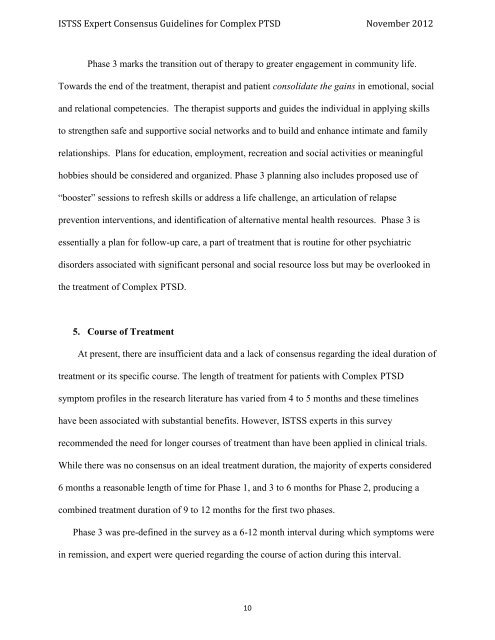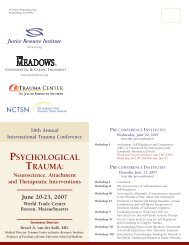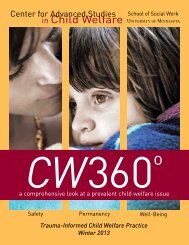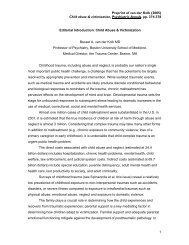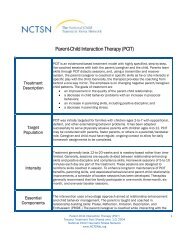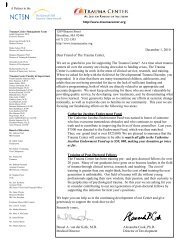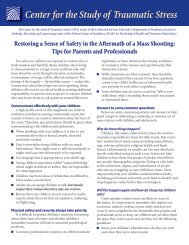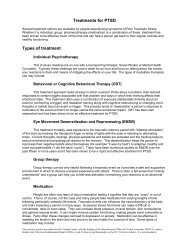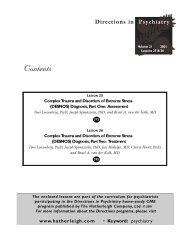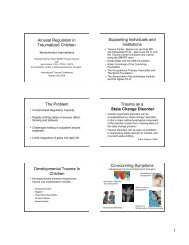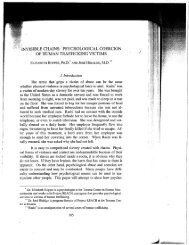ISTSS Expert Consensus Treatment Guidelines for Complex PTSD
ISTSS Expert Consensus Treatment Guidelines for Complex PTSD
ISTSS Expert Consensus Treatment Guidelines for Complex PTSD
Create successful ePaper yourself
Turn your PDF publications into a flip-book with our unique Google optimized e-Paper software.
<strong>ISTSS</strong> <strong>Expert</strong> <strong>Consensus</strong> <strong>Guidelines</strong> <strong>for</strong> <strong>Complex</strong> <strong>PTSD</strong> November 2012<br />
Phase 3 marks the transition out of therapy to greater engagement in community life.<br />
Towards the end of the treatment, therapist and patient consolidate the gains in emotional, social<br />
and relational competencies. The therapist supports and guides the individual in applying skills<br />
to strengthen safe and supportive social networks and to build and enhance intimate and family<br />
relationships. Plans <strong>for</strong> education, employment, recreation and social activities or meaningful<br />
hobbies should be considered and organized. Phase 3 planning also includes proposed use of<br />
“booster” sessions to refresh skills or address a life challenge, an articulation of relapse<br />
prevention interventions, and identification of alternative mental health resources. Phase 3 is<br />
essentially a plan <strong>for</strong> follow-up care, a part of treatment that is routine <strong>for</strong> other psychiatric<br />
disorders associated with significant personal and social resource loss but may be overlooked in<br />
the treatment of <strong>Complex</strong> <strong>PTSD</strong>.<br />
5. Course of <strong>Treatment</strong><br />
At present, there are insufficient data and a lack of consensus regarding the ideal duration of<br />
treatment or its specific course. The length of treatment <strong>for</strong> patients with <strong>Complex</strong> <strong>PTSD</strong><br />
symptom profiles in the research literature has varied from 4 to 5 months and these timelines<br />
have been associated with substantial benefits. However, <strong>ISTSS</strong> experts in this survey<br />
recommended the need <strong>for</strong> longer courses of treatment than have been applied in clinical trials.<br />
While there was no consensus on an ideal treatment duration, the majority of experts considered<br />
6 months a reasonable length of time <strong>for</strong> Phase 1, and 3 to 6 months <strong>for</strong> Phase 2, producing a<br />
combined treatment duration of 9 to 12 months <strong>for</strong> the first two phases.<br />
Phase 3 was pre-defined in the survey as a 6-12 month interval during which symptoms were<br />
in remission, and expert were queried regarding the course of action during this interval.<br />
10


